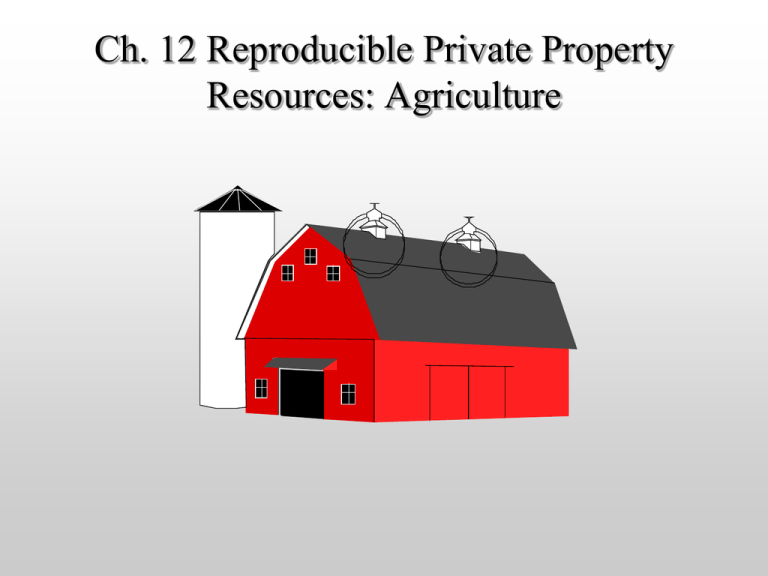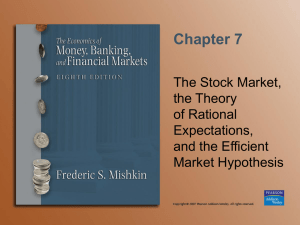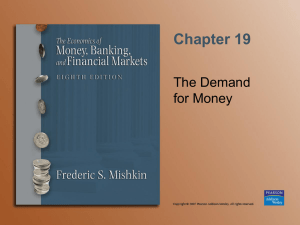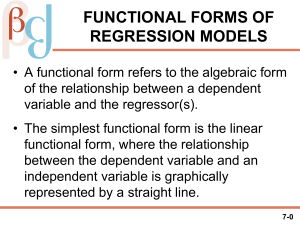
Ch. 12 Reproducible Private Property
Resources: Agriculture
Introduction
Over 840 million people suffer from chronic
hunger & malnutrition;
> ¼ of these are children (215 million)
– most live in South Asia & Southern Africa.
– Haiti, Tajikistan, & Sierra Leone have over 50%
of population is undernourished
Total amount of food available is not problem
– World produces 17 % more calories per person
today than 30 years ago
Introduction
Why has this problem arisen?
3 common hypothesis:
1) persistent global scarcity of food.
2) maldistribution of food.
3) temporary shortages caused by weather and
other natural causes.
Formulating Global Scarcity Hypothesis
Two forms of the hypothesis:
1) Strong form: per capita food production
is declining
2) Weak form: relative price of food is
rising due to steep supply curve.
Price of
Food
Fig. 12.1 The market for
Food
Inelastic
Sb Supply
P5b
Elastic
Sa Supply
P5a
P0
Quantity
of Food
Q0
Q5b
Q5a
Testing the Hypothesis
Per capita food production has increased in
world and developing countries implies that
strong form can be rejected.
Food prices have risen more rapidly than
inflation in about half of the countries, thus
there is some support for weak form of the
hypothesis
TABLE 12.1 Trends in U.S. Agriculture
A 20th-Century Time Capsule (1 of 2)
Copyright © 2009 Pearson Addison-Wesley. All rights
12-7reserved.
TABLE 12.1 Trends in U.S. Agriculture
A 20th-Century Time Capsule (2 of 2)
Copyright © 2009 Pearson Addison-Wesley. All rights
12-8reserved.
Outlook for the Future
1930 to 200 yields per acre increased from 30
to 130 bushels
Milk and dairy production increased from
4,572 pound in 1944 to 10,000 pounds by
1971. By 2000 it was 17,000 pounds per cow.
Huge shift to mechanization on U.S. farms
Outlook for the Future
1) Technological progress: 3 techniques
– 1)recombinant DNA
– 2)tissue culture
– 3) cell fusion
Applications
–
–
–
–
1)making food crops more resistant to disease/pests
2)hardy crops; drought resistance; poor soil
3)crops make their own fertilizer
4)increasing crop yields
Outlook for the Future (cont.)
Five problems
– 1)allocation of agricultural land
» Trend of increasing shift from agric. to urban use can’t continue
» Corn for ethanol has caused price to rise
– 2)energy costs
– 3)environmental costs: too much fertilizer and pesticide use
pollutes water
» U.S. nitrogenous fertilizer use 300% in past 25 years
» Netherlands 150%; Denmark 225%
» Also soil erosion causes negative externality
– 4) Growth in Organic Foods
» organic food sector is growing; 2.8% of U.S. food sales now
TABLE 12.2 Pesticide
Consumption per Hectare of
Agricultural Land (Kg/Ha)
Copyright © 2009 Pearson Addison-Wesley. All rights
12-12
reserved.
TABLE 12.3 Comparison of EU and U.S.
Standards for Organic Certification
Copyright © 2009 Pearson Addison-Wesley. All rights
12-13
reserved.
TABLE 12.3 Comparison of EU and U.S.
Standards for Organic Certification
Copyright © 2009 Pearson Addison-Wesley. All rights
12-14
reserved.
The Role of Agricultural Policies
Four types of agricultural policies have
subverted normal functions of price system:
– 1) subsidies for specific farming inputs
including fertilizers and pesticides
– 2) guaranteed prices for outputs
– 3) marketing loans based on crop prices
– 4) trade barriers to protect against competition
from imports.
Copyright © 2009 Pearson Addison-Wesley. All rights
12-15
reserved.
FIGURE 12.2 Farm Program Payments as a Share
of Production Value, 2002-2005 Crop Years
Copyright © 2009 Pearson Addison-Wesley. All rights
12-16
reserved.
A Summing Up
Some countries are beginning to eliminate
some of the price supports and subsidies.
Genetically modified foods are a new
source of controversy.
Copyright © 2009 Pearson Addison-Wesley. All rights
12-17
reserved.
Distribution of Food Resources
The second of the three hypotheses used to
explain widespread malnourishment.
This hypothesis suggests that it is
imperfections in food distribution,
particularly in less developed (or poorer
countries) that cause the malnourishment
problem. Thus, the problem is one of
poverty not a lack of food, suggesting
different policy prescriptions.
Copyright © 2009 Pearson Addison-Wesley. All rights
12-18
reserved.
Defining the Problem
Evidence from the United Nations suggests
that the problem is one of nonuniform
distribution.
Chapter 6 suggested that high poverty levels
are generally conducive to high population
growth which leads to more income
inequality
Copyright © 2009 Pearson Addison-Wesley. All rights
12-19
reserved.
TABLE 12.4 Food Situation in
Developing Countries
Copyright © 2009 Pearson Addison-Wesley. All rights
12-20
reserved.
Domestic Production in Less
Developed Countries
Most developing countries lack foreign exchange
with which to buy food imports.
The law of comparative advantage says that
nations are better off specializing in those
products for which they have a comparative
advantage—measured in the opportunity cost of
another good.
Price distortions and externalities associated with
agriculture have caused most developing countries
to have an excessive dependency on imports.
Copyright © 2009 Pearson Addison-Wesley. All rights
12-21
reserved.
Undervaluation Bias
Two government programs undervalue
agriculture and destroy incentives:
1) Marketing boards
– holds food prices down
– import artificially cheap food from the U.S.
2) Export Taxes:
–
–
–
–
source of revenue
makes food products more expensive to sell abroad
reduces farmer incentives to produce food
farmers try to smuggle it out of country
Feeding the Poor
Advantages of food stamps
Improve income distribution from agricultural
production:
– Green revolution: maize hybrids caused
productivity to double or triple for small farmers in
Central America, East Africa, East Asia, Mexico,
India, Pakistan.
– Developing countries need sustainable technologies
(e.g. solar powered irrigation systems) and
financial capital for famer owned local
cooperatives
Feast and Famine Cycles
1) Cobweb Model
– farm output and prices fluctuate greatly
– model presents one explanation for this volatility
– assumptions:
» farmers forecast next year’s price based on this year’s
» if prices are high this year, produce large supply next
year, making price fall
» low price this year is also next year’s forecast, so
produce small supply next year and so on and so on.
Fig. 12.3 The Cobweb Model
Price
S
P0
P3
P1
D
Quantity
Q0 Q3
Q1
Feast and Famine Cycles (cont.)
Price Elasticity and Farm Revenues
– demand for most farm products is price inelastic
– this implies that farm revenues will fall in “good”
weather years and will rise in “bad” weather years
Price
P2
P1
P0
Fig. 12.4 Price Elasticity of Demand and the Size of
Price Fluctuations
B
C
A
D
D1
D2
Quantity
S1
S0












